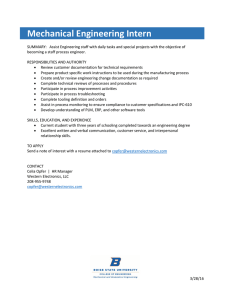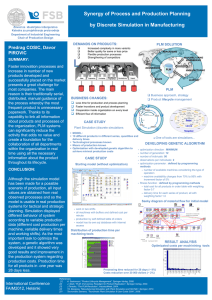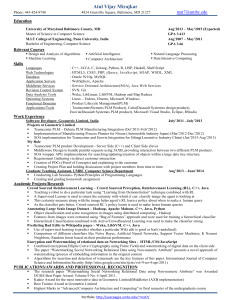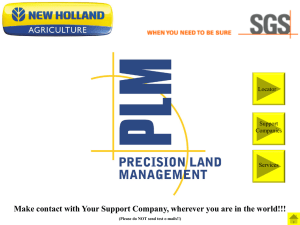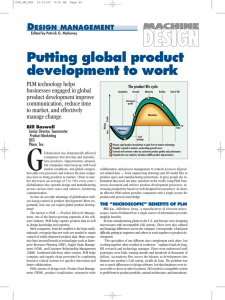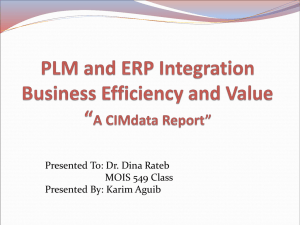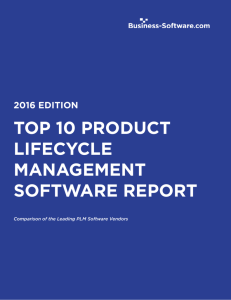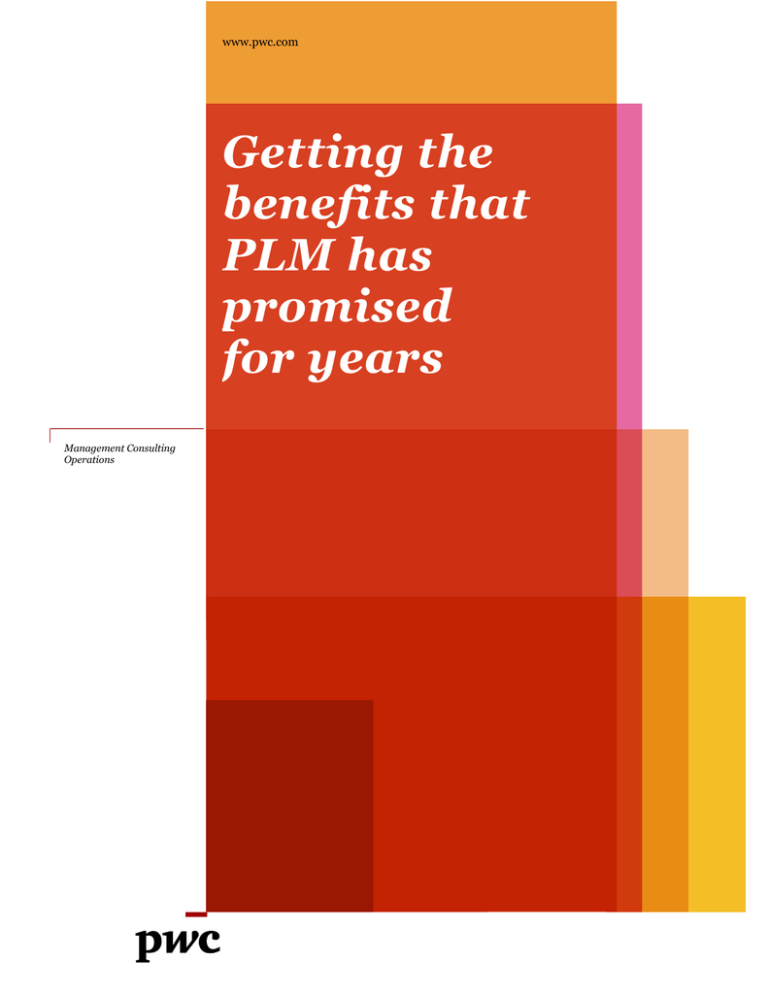
www.pwc.com
Getting the
benefits that
PLM has
promised
for years
Management Consulting
Operations
Getting the benefits that PLM has
promised for years
Unfortunately, product lifecycle management
(PLM) implementations often fall short of
users’ expectations. Now, though, leading
companies are starting to see a way that PLM
projects may deliver the kinds of benefits
described in the brochures. One hint: Treat
PLM as a critical business system rather than as
a productivity tool for engineers—and take the
time to agree on a PLM strategy first.
The executives at one industrial conglomerate faced a challenge. The
company had spent tens of millions of dollars on a software implementation,
but had little to show for it. Too little had been done to align engineering
teams with operations staff before the solution was rolled out. As a result,
engineers continued to spend valuable time maintaining bills of materials
(BOMs) rather than designing new products.
Many PLM implementations have not lived up to their promise of helping
businesses manage their product-related information—across lifecycles,
supply chains, and value chains—in order to bolster revenue growth. In our
experience, many companies are disappointed with the returns on their
PLM investments following implementation—sometimes long after.
Fortunately, more and more business leaders, seeing the need for improved
PLM capabilities, are taking another run at them. This time, they are
starting out by developing clear PLM strategies that pave the way for
“measure twice, cut once” implementations rather than rushing into
software configuration.
Operational scalability makes PLM more important
than ever
The long-term viability of product companies increasingly depends on how
well they manage their product information across multiple internal and
external functions, from R&D to customer service, as their products and
organizations become more complex.
At its core, PLM provides an integrated approach to sharing and controlling
critical data so products are built correctly, sourced properly, and costed
accurately—an approach that applies to a product offering from concept
through end of life. The discipline is broad, spanning product development
and supply chain. It is truly cross-functional, involving multiple core
processes and extending to the company’s key design and supply partners.
Getting the benefits that PLM has promised for years
1
Yet PLM has been seen largely as an engineering “sell” rather than as a key
enabler for running increasingly complex global businesses. It has tended to
be seen more as a one-off program—not as a system that is integral to
ongoing business operations. Sadly, there are plenty of instances where
companies have worked through many of the PLM challenges, only to have
the overall effort fail when engineering managers were unable to convince
the C-suite to drive compromises across functions.
Planned and executed well, PLM implementations can significantly improve
efficiency and effectiveness—vital as product development spreads across
large ecosystems of partners, supply chains stretch around the globe, and as
regulatory pressures rise worldwide.
What your business can do to enable PLM success
So what does it take to rejuvenate a struggling PLM initiative, or to get a new
one off to a good start? The scope and scale of most PLM implementations
demand answers, of course. The reality is that PLM systems are different
than other enterprise systems such as customer relationship management or
enterprise resource planning systems, and therefore have their intricacies.
PLM applications behave differently, their user communities are often more
demanding, and the relevant business processes often cross more
organizational boundaries.
With those caveats in place, the following actions can make a huge
difference:
Tie PLM strategy shoelaces before running. Many companies
now understand that PLM success starts with PLM strategy. That means
getting clarity about how PLM can help the organization attain its
business objectives, and then establishing the governance and the
continual executive leadership needed to facilitate success over the long
term. As relationships between engineering, supply chain, and external
partners become more complex, securing the right cross-functional
sponsorship becomes critical to implementing the strategy and
delivering the benefits.
Agree on a clear, simple business rationale for PLM. If only
one side—the engineering team, say—is driving a major PLM initiative,
then the odds aren’t as good that the other groups, such as
manufacturing, will support the proposal. We’ve seen several instances
where one group balks—sometimes withdrawing their funds and/or
resources—when their critical functionality falls later on the PLM
roadmap than that of another group.
Get all sides speaking the same language. A recent discussion
with a top development engineer highlights the challenge: He
continually asked about PLM, but it turned out that he really meant
computer-aided design. Such confusion can be really damaging,
Getting the benefits that PLM has promised for years
2
especially when trying to get R&D and operations teams to sit on the
same side of the table. This is more critical with PLM than with most
other large enterprise solutions because functional managers are often
confused by the terminology used by software vendors. Only when there
is concrete agreement about the meaning of terms such as “bill of
materials” can there be talk about who “owns” various PLM processes
and how they should be managed. Neutral third parties can help
pinpoint these disconnects, and facilitate the first meetings to set
consensus around the offending terms.
Don’t hand off to IT. Too many companies treat PLM as an
information technology (IT) system implementation job. If the business
leadership assumes that the information systems component is the
primary source of benefit, it may hand over the responsibility to the IT
department, with only a perfunctory business process analysis. But that
rarely works—and it isn’t really fair to IT. Certainly, IT will need a seat
at the table since it will play a significant role in implementing the
solution. But PLM must be owned by the core business functions
involved: R&D, manufacturing, supply chain, finance, and others.
Demonstrate success with a carefully chosen, highly visible
pilot. Management often agrees to support PLM programs, but doesn’t
always have the intestinal fortitude to drive such large and complex
initiatives. A better approach may be to start with a pilot program in a
business unit whose outputs everybody agrees are mainstream and
substantial. This approach starts to defuse the “yes, but it’ll never work
here” argument. While there are many examples of successful smallscale PLM roll-outs, they often occur in business units that are the
products of acquisitions, and therefore are seen as more likely to
succeed. With a highly visible pilot, using industry-standard processes
and practices, the organization can quickly prove feasibility for the
organization as a whole. So there must be a plan not only to celebrate
the “quick win” but to follow it with expanded PLM trials.
Clearly, effective PLM implementations require a fusion of classic change
management disciplines as well as deep knowledge of business operations
and a rock-solid grounding in engineering. For many organizations, an early
challenge may be to convince senior management to release additional
funds for the change management initiative needed to improve the
likelihood of a flawless and successful implementation.
Such challenges should not dampen the resolve of business leaders to get
their PLM deployments right, and to reap the rewards of doing so. The tools
are highly capable—quite enough for PLM to deliver the benefits it has
promised for years. Governed, managed and executed well, PLM has the
potential to become a true strategic capability—helping to drive innovation
across a product’s lifecycle. The way forward is clear. Now there must be the
will to follow it.
Getting the benefits that PLM has promised for years
3
For more information, please contact:
Tim Burks
Director
tim.burks@us.pwc.com
Paul Cantrell
Director
paul.cantrell@us.pwc.com
© 2012 PricewaterhouseCoopers LLP, a Delaware limited liability partnership. All rights reserved.
PwC refers to the US member firm, and may sometimes refer to the PwC network. Each member firm is a separate legal entity. Please see
www.pwc.com/structure for further details.
This content is for general information purposes only, and should not be used as a substitute for consultation with professional advisors. PwC US
helps organizations and individuals create the value they’re looking for. We’re a member of the PwC network of firms with 169,000 people in more
than 158 countries. We’re committed to delivering quality in assurance, tax and advisory services. Tell us what matters to you and find out more by
visiting us at www.pwc.com/us.

